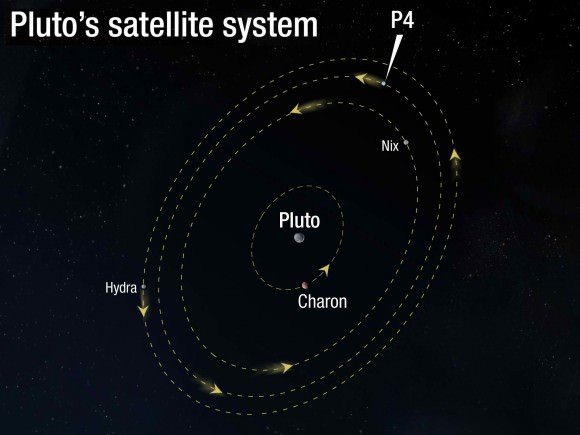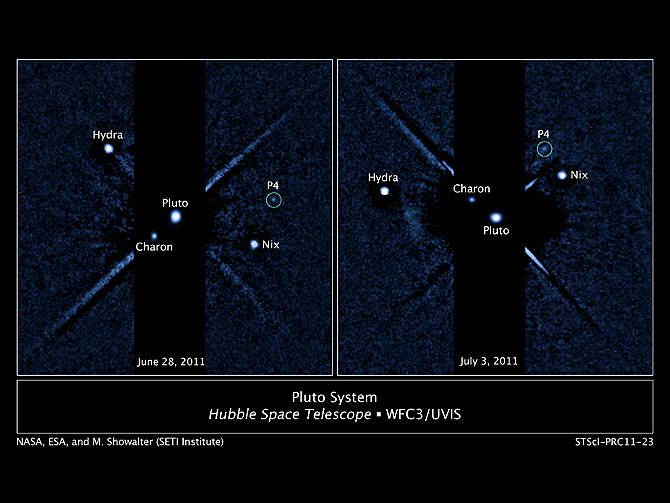[/caption]
Astronomers using the Hubble Space Telescope discovered a fourth moon orbiting the icy dwarf planet Pluto. The tiny, new satellite – temporarily designated P4 — was uncovered in a Hubble survey searching for rings around the dwarf planet.
The new moon is the smallest discovered around Pluto. It has an estimated diameter of 8 to 21 miles (13 to 34 km). By comparison, Charon, Pluto’s largest moon, is 648 miles (1,043 km) across, and the other moons, Nix and Hydra, are in the range of 20 to 70 miles in diameter (32 to 113 km).
“I find it remarkable that Hubble’s cameras enabled us to see such a tiny object so clearly from a distance of more than 3 billion miles (5 billion km),” said Mark Showalter of the SETI Institute in Mountain View, Calif., who led this observing program with Hubble.
The finding is a result of ongoing work to support NASA’s New Horizons mission, scheduled to fly through the Pluto system in 2015. The mission is designed to provide new insights about worlds at the edge of our solar system. Hubble’s mapping of Pluto’s surface and discovery of its satellites have been invaluable to planning for New Horizons’ close encounter.
“This is a fantastic discovery,” said New Horizons’ principal investigator Alan Stern of the Southwest Research Institute in Boulder, Colo. “Now that we know there’s another moon in the Pluto system, we can plan close-up observations of it during our flyby.”
The new moon is located between the orbits of Nix and Hydra, which Hubble discovered in 2005. Charon was discovered in 1978 at the U.S. Naval Observatory and first resolved using Hubble in 1990 as a separate body from Pluto.

The dwarf planet’s entire moon system is believed to have formed by a collision between Pluto and another planet-sized body early in the history of the solar system. The smashup flung material that coalesced into the family of satellites observed around Pluto.
Lunar rocks returned to Earth from the Apollo missions led to the theory that our moon was the result of a similar collision between Earth and a Mars-sized body 4.4 billion years ago. Scientists believe material blasted off Pluto’s moons by micrometeoroid impacts may form rings around the dwarf planet, but the Hubble photographs have not detected any so far.
“This surprising observation is a powerful reminder of Hubble’s ability as a general purpose astronomical observatory to make astounding, unintended discoveries,” said Jon Morse, astrophysics division director at NASA Headquarters in Washington.
P4 was first seen in a photo taken with Hubble’s Wide Field Camera 3 on June 28. It was confirmed in subsequent Hubble pictures taken on July 3 and July 18. The moon was not seen in earlier Hubble images because the exposure times were shorter. There is a chance it appeared as a very faint smudge in 2006 images, but was overlooked because it was obscured.
For more images and information, see the HubbleSite.


hst ftw!
this is so sad. why do we have only one moon? even mars have two! cruithne doesn’t count.
We do technically have two…
“quasi-satellite” shmashi-satellite…
True, but ours is one of the largest in the solar system! Our moon could crush Phobos & Deimos.
Poor Venus though…
Because our own didn’t fail to reassemble.
I believe one current idea is that the largest “moonoid” (analogous to planetoid) after the impact event was last assembled and then collected the remainders (analogous to planet formation). In other systems they have spread out and become lost/re-impacted, perhaps because their parent bodies are so much smaller.
is this somehow connected with the mentioned dynamical dominance criteria and our moon being above the lambda=1 line? so even if there were some moonoids after the impact that could have had a stable orbit, they were cleared out by the proto-moon?
We’re not technically supposed to have a Moon. Think about it. Mercury and Venus, the two closest planets to the sun, don’t have moons. Mars’s moons are captured asteroids and ours was (likely) created from an impact. To be honest we’re lucky to even have a moon in the first place since there’s no other place for Earth to get one.
Top marks to HST and the team involved. Despite the different technologies, how might JWST resolve Pluto and her satellites?
lets call it Tartaros (http://en.wikipedia.org/wiki/Tartarus)
“In Greek mythology, Tartarus is both a deity and a place in the underworld.”
That would work, Charon is greek too. Though it’s up to the finders to name it, I believe.
lets call it Tartaros (http://en.wikipedia.org/wiki/Tartarus)
I’m agree with mr. Richard Raue, let’s call it Tartaros
Amazing work from Hubble!
How about Cerberus?
We should name it Nathan Contarino
“It was not seen, P4.”
[I’ll take IVAN3MAN’s coat and go now. :O]
But is a moon around a non-planet really a non-moon?
This hypothesis for the formation of this little cold system seems to bring questions to the whole reasoning for dethroning Pluto off the list of planets. The reason cited was the Pluto could not gravitationally “clear” is orbital region. If there were such collisions and the gravitational coalescence of this system, that sounds a bit like “clearing.”
LC
Did you think it was such a marginal difference between these different populations? (Planets vs KBOs.) Many asteroids have moons.
The dynamical dominance criteria (DDC) is based on deflection of neighboring orbit-sharing planetesimals, not capture of moons. It makes a natural classification with 5 orders of magnitude separation between the two observed classes (fig 2). I think you have to paddle a lot more to clear the waters around that criteria.
Besides, if some body [sic!] would be classified as planet from DDC aspects, it would be our Moon (same fig)! Is the Earth-Moon system a twin planet or a twin moon or something else entirely? You decide.
The Earth-moon system I have heard described as a double planet. In fact the system is the only one where a moon is such a significant percentage 1.25% of the planet. It does sort at least border on being a double planet.
The problem is that we like to classify things, and nature often has a way of confounding such efforts.
LC
Pluto is not clearing the region of the Solar System where it orbits, which has thousands of planetoids larger than 100 km. and millions of comets. It’s only clearing its immediate vicinity.
There is also a lot more spatial volume to clear out there. It is unlikely such a body exists, but if there is a gas-giant or brown dwarf out there at 100AU or more it might be that this does not clear its neighborhood either due to the long orbital period and the large circumference of its orbit. Yet by this definition such an object would fail to be a planet.
I sometimes think the notion of a planet needs to be revised. Terrestrial planets are different physically from gas giants, but we lump them into the same generic category. I wonder if a better scheme is for terrestrial planets, gas planets and then plutoid planets.
LC
Speaking of moon formation, and in the context of re00r’s plaint, this abstract from an oral session of the EPSC-DPS Joint Meeting 2011 may be of interest [edited for readability]:
“Despite many efforts an adequate theory describing the origin of Phobos and Deimos has not been realized. In recent years a number of separate observations suggest the possibility that the Martian satellites may have been the result of giant impact [1].
Similar to the Earth-Moon system, Mars has too much angular momentum. A planetesimal with 0.02 Mars masses must have collided with that planet early in its history in order for Mars to spin at its current rate [2]. Although subject to considerable error, current crater scaling laws and an analysis of the largest known impact basins on the Martian surface suggest that this planetesimal could have formed either the proposed 10,600 by 8,500-km-diameter Borealis basin, the 4,970-km-diameter Elysium basin, the 4,500-km-diameter Daedalia basin or, alternatively, some other basin that is no longer identifiable. It is also probable that this object impacted Mars at a velocity great enough to vaporize rock (>7 km/s), which is necessary to place large amounts of material into orbit.
If material vaporized from the collision with the Mars-spinning planetesimal were placed into orbit, an accretion disk would have resulted. It is possible that as material condensed and dissipated beyond the Roche limit forming small, low-mass satellites due to gravity instabilities within the disk. Once the accretion disk dissipated, tidal forces and libration would have pulled these satellites back down toward the Martian surface. In this scenario, Phobos and Deimos would have been among the first two satellites to form, and Deimos the only satellite formed–and preserved– beyond synchronous rotation.
[Goes on to describe evidence and test for the scenario, such as orbital parameters, low moon masses, many equatorial elliptical impact scars on Mars, et cetera.]
In the formation of the Moon, the last body to form from the accretion disk would, by necessity, be more massive than the rest. Thus this large satellite would recede from the proto-Earth faster, accrete the smaller satellites, and form the Moon. However, in the Martian scenario this last, large satellite does not form, and Mars is left with a number of small, Phobos and Deimos-size objects.
3. Summary and Conclusions
In this scenario the orbital eccentricity and inclination of both Pbobos [sic] and Deimos, which are the hardest parameters to explain in any other model, are the natural results of having formed in an accertion [sic] disk. The amount of material ejected into Martian orbit following the giant impact is calculated to be extremely low—less than 0.5% of the impacting object. Also, unlike the Earth-Moon system, it is not necessary for the accretion disk to coalescence into one massive object.
Thus, it is actually easier for Phobos and Deimos to have formed from a giant
impact than it is for the Earth’s moon.”
Incredible! Even after Pluto was demoted, we’re still discovering stuff about it.
Thanks HST!
Agreed; it was unduly promoted before.
Luckily Dawn will characterize some asteroids and planetoids at least marginally before we get to the more distant and for planetary formation science likely less important KBOs. Priorities ass-wise saved by a hair.
The astronomy textbook makers will be pissed!!! Great find HST!!!
Only because they have to add to another edit, which are routine.
Frankly, I think they will be delighted, as they are probably astronomers.
I think they will be delighted because every new revision is a new chance for the publishers to cash in on sales.
Call it George. ‘Bout time there was a planetoid called George.
In keeping with classical underworld allusions, according to Dante the third circle, or orbit as it were, of Hell is gluttony. The goddess of gluttony is Adephagia.
Pluto was so named in 1930 by an 11 year old girl called Venetia Phair she is still alive today at a tender 87 years young:
http://news.bbc.co.uk/2/hi/4596246.stm
The first two letters of Pluto also happen to coincide with Percivel Lowell’s initials.
Sadly, Venetia passed away in 2009 at the age of 90: http://www.nytimes.com/2009/05/11/world/europe/11phair.html?_r=1&scp=1&sq=Venetia%20Phair&st=cse
A super sentiment many thanks for the link, there are a number of obituaries on the internet to her beloved memory…. a sad loss.